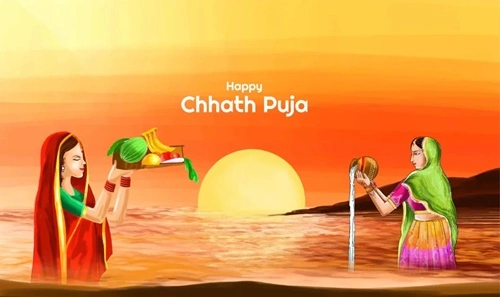The festival of Chhath Puja is one of the most revered and deeply-rooted observances in the Hindu calendar, especially in the states of Bihar, Jharkhand, Uttar Pradesh and in neighbouring Nepal. It is a four-day festival dedicated to the worship of the Sun God (Surya) and his sister, the goddess Chhathi Maiya (also perceived as an aspect of dawn or the rising Sun). The devotees observe rigorous rituals including baths in sacred water bodies, fasting, offerings at riverbanks at sunrise and sunset, all to express gratitude for the gift of life, for nature’s bounty and invoke blessings of health, prosperity and longevity.

Chhath Puja Date & Shubh Muhurat for 2026
According to the Panchang for New Delhi (and broadly northern India), the main day of Chhath Puja in 2026 falls on Sunday, 15 November 2026. Key timing details:
- On the day of Chhath (Shashthi), sunrise is at 06:44 AM local time.
- Sunset on the same day is at 05:28 PM (approx.) as per the source.
- The festival spans four days:
- Day 1 (“Nahay Khay”) begins Friday, 13 November 2026.
- Day 2 (“Kharna” or fast-day) is Saturday, 14 November 2026.
- Day 3 (the major “Sandhya Arghya” — evening offering) is Sunday, 15 November 2026.
- Day 4 (“Usha Arghya” – morning offering & breaking the fast) is Monday, 16 November 2026.
Thus, if you are planning to participate in or organise the Chhath-observance in 2026, you should prepare for the core rituals especially on 15 November with the early-morning sunrise time being particularly crucial for the Usha Arghya on the final day.
Significance of Chhath Puja
Mythological & Spiritual Basis
- Chhath honours the Sun—Surya—and his sister or consort (depending on tradition) Chhathi Maiya, acknowledging the primal role of the Sun in sustaining life, energy, growth and time-cycles.
- The legends say that by offering Arghya (water offerings) to the setting and rising Sun, devotees show their respect for the cycle of day and night, the light that dispels darkness, and they pray for the welfare of their family, children and community.
- The festival also emphasises gratitude for nature and water-bodies — many rituals involve riverbanks, ghats, lakes, reinforcing the interconnection of human life with the environment.
Social & Cultural Meaning
- The four-day discipline (bathing, fasting, offering, breaking fast) symbolises self-purity, dedication and community spirit.
- In regions such as Bihar and Jharkhand, Chhath is more than a family occasion — it becomes a communal event: entire villages congregate on river-banks, observe in unison, prepare special foods, decorate, share prasad and reinforce cultural bonds.
- The timing just after the major festival of Diwali underscores transition: from darkness (Diwali) to light and gratitude (Chhath), reaffirming optimism, renewal and hope.
Why it matters
- For families, especially in agrarian contexts, the Sun’s role is direct — crops, harvests, animals all depend on sunlight and water. Thus, invoking the Sun’s blessings is practical as well as symbolic.
- The collective fast and offering promote a kind of spiritual reset: acknowledging what we have, blessing what we seek, and recognising the dependent-nature of life.
- It unites generations—children accompany adults to ghats, elders impart stories and tradition, younger people join in rituals: it keeps cultural continuity alive.
How to Observe Chhath Puja – Ritual Highlights
Day 1 – Nahay Khay: Devotees (usually women who will observe the fast) take a clean bath in a river or water-body, collect water, prepare a modest vegetarian meal (often rice & greens) and eat in the evening.
Day 2 – Kharna: The devotee observes a full day fast (without even water), culminating in evening offerings and special sweets (such as kheer made of jaggery).
Day 3 – Sandhya Arghya: At sunset, the devotee goes to the river-bank or ghats, stands in water, offers Arghya (water offering) to the setting Sun, lights diyas (lamps) on the banks and remains standing in water till night.
Day 4 – Usha Arghya & Parana (Breaking Fast): At sunrise the next morning the devotee again offers Arghya to the rising Sun, then breaks the fast, consumes prasad, and completes the ritual.
In 2026, the sunrise time for the main day is about 06:44 AM — so the early morning ritual must be timed accordingly.
Tips for 2026 Preparation
- Plan ahead for the ghats or water-body you will use — riverside spots fill up quickly.
- Check local muhurat if you are outside Delhi—sunrise, sunset and tithi timings may vary by location.
- Prepare offerings & prasad: Fresh fruits, sugarcane, seasonal vegetables, kheer, thekua (a sweet from Bihar) and lamps/diyas.
- Water-safety: For standing in rivers near sunset or early morning, ensure the spot is safe; take care of older or younger participants.
- Community participation: Encourage family members or neighbours to join; the festival gets richer with shared devotion.
- Observe with mindfulness: While the bifurcated jumps (fasting, then river offering) are demanding, the heart of Chhath is gratitude—use the time to reflect and give thanks.
As we look forward to Chhath Puja 2026, may the rising Sun bring you light, strength and prosperity. May your offerings be accepted, your prayers heard and your home be filled with peace and renewal.